The last month has been the best grunter fishing I’ve seen in the whole time I’ve lived in Townsville, and we are getting consistent results on lures every time we decide to chase them.
It’s no coincidence that the rain started the prawns and crabs running and then the golden snapper (fingermark) and grunter came on the bite just a week or two after the run-off disappeared. The lack of rain over the last few years has really taken its toll on fish stocks. That old adage ‘drought in land, drought at sea’ rings true once again. It’s a common theme around Australia and basically refers to the fact that plenty of estuary inhabitants rely on considerable amounts of rain to reproduce, and this in turn draws in the predators. One stint of reasonable rain was the trigger for the current grunter run. I don’t know where they hide during dry spells, but they’ve come out of nowhere over the last few weeks.
Small lures are normally the go for these tasty fighters, and they are also one species that has a definite colour preference each and every time you venture out in search for them. The strange thing is with this species that the preferred colour is different almost every time you go out in search for them. For instance, when the young fella and I first found them they went off their heads for the bright white 4” Atomic Prong BUT it was the tail being dipped in the Green Quick Coat Worm Dip that seemed to be the real trigger. This was an early morning stint, and almost every cast got hit once we found the right colour combination. It was one of those times when they definitely had a colour that they hit much better than anything else we threw at them on that given day.
There are plenty of anglers who think that various lure colours catch anglers not fish, and to a certain degree I would go along with this theory, but only sometimes. Grunter seem to react to a certain colour on a certain day better than others. While we can sometimes stumble across the right colour straight up, we can often go through several colour combinations before we nail it. That being said, there are natural indicators that can give you a few hints on where to start. For example, early morning sessions with small tidal flows and not much wind are the times when the white with coloured tail works a treat, but throw in a few knots of wind, a bit bigger tide and stirred sediment and all of a sudden the more successful colours are completely different. Less penetrating light in deeper water where the bigger fish hang out calls for something more easily seen in the darker depths, and the fluorescent orange Halco 5” Paddle Prawn becomes my go-to lure. Once you see this particular lure in the water, you’ll see why.
It’s not just colour that can get the bite happening; size is another factor that can absolutely have a bearing on success levels. My 9yr old son Tannhym has an obsession with the ‘giggle stick’. This is our term used for the ultra light gear that we drag out when things either get a bit mundane or the bites are not happening and we decide to have a bit of fun with small GTs etc. It’s no coincidence that when he pulls out the giggle stick he ends up landing the fish of the trip, or stumbles across a bite that was completely lure size orientated. Tiny 3” Prongs or Plazo flick baits jabbed across the bottom on short, sharp rod twitches on his 6lb outfit usually end up with him giggling and losing line at a great rate of knots. It’s truly been a case of the teacher getting taught, and we never hit the water now without a ‘giggle stick’ each.
In the 4-8m mark around shelly patches the golden snapper have definitely been a worthwhile target species. Lately our process of seeking them out has involved trolling a couple of 125mm Scorpions at 5m or 8m through likely looking areas at slow speeds while our eyes are glued to the sounder. I use a Lowrance HDS 7 side scan for this dialled in type of luring, and the precision and accuracy that we can get with our presentations on individual fish and smaller schools is extraordinary. As soon as a fish is hooked or a solid bite is detected I instantly hit the spot lock and once the fish has been landed start to throw plastics around that area when there were a few fish holding. It’s amazing how many times we have had great sessions on golden snapper using this exact method of discovering the feeding schools.
Now that the initial barra buzz has subsided a bit since opening, we’ll probably start to chase them a bit more now that the preferred spots will get a little quieter. This month’s tides were quite big and this concentrates barra anglers in quite specific areas. This is one of the reasons we have been targeting the golden snapper and grunter more regularly. Around the city itself, the break walls are fishing very well, and a range of lures from paddle tailed shads, prawn imitations and hardbody shallow and deep divers have worked well. Some cracking fish have been encountered and quite a few metre fish have been landed and released in the flow of the city lights.
During the daylight hours there are plenty of fish taking live baits, and not uncommon are quality fish sucking in fresh baitfish fillets meant for other species. Using poppers is a technique that has been bringing legal size barra undone, and around a tide change is the best option. The freshwater reaches of the Ross River have been a great place to cast a lure for barra, particularly on those windy days that have a little cloud cover and drizzle. It is a great place to spend a few hours getting your fishing fix when the weather suggests otherwise. The weed is thick here so weedless is the best approach but the visual bite during daylight hours is worth every cast.
Apart from the big schools of bait that are around at present, no one can really explain the schools of Spanish that have shown up in the last couple of weeks in the warm waters. Dozen-fish sessions are quite common for the guys trolling deep divers, with the average fish being 7-10kg. The slightly smaller Halco 160 Laser Pro has been catching plenty of these safe eating size fish. With dual tow points the 160 Laser gives a couple of different options for depth and action, and connecting to the actual bib tow point has been the most successful presentation at present. This allows faster troll speeds and a more flat profiled presentation, and while the bigger fish won’t pass them up, the smaller are more inclined to have a go, so it’s a win-win situation.
The smaller species such as schoolies are also about and small slugs and slices like the Halco Twistie and the Outcast are a great choice for those wishing to target them in shallow areas. The technique for this is really as simple as it gets. Either cast into an area that you suspect is holding them, or hold directly above them and allow your lure to hit the bottom. Jig once, wind up the slack, jig twice and then crank flat knacker to the boat and hang on. We usually target these smaller species on the giggle sticks when the sharks aren’t too bad, but if those buggers are around heavier line will save them being turned into shark poo.
I often talk with Ross from Ultimate Sport Fishing Charters to get an idea of what’s happening offshore and he said that the nannies, reds and trout have been very consistent in 30-40m of water.
As far as trends go, the slow jigging phenomenon is in full swing now. Some very parabolic rods have been developed for this technique and apart from that, the only real revolution has been the lure designs themselves that have been fine tuned for this environment. There’s no denying the results, with some massive fish being taken on these relatively tiny lures sporting minuscule hooks. Everything from golden snapper to trout and all sorts of species in between will at times hit these little things. Smooth drags and long leaders are two of the most important things an angler needs to pay attention to when setting up for jigging (apart from the rod selection).
All in all there’s plenty to keep you occupied over the coming months.
Reads: 2177
On those gloomy and windy days when the enthusiasm levels cop a battering, casting surface stuff in the fresh water reaches of the Ross can give you that buzz we all seek.
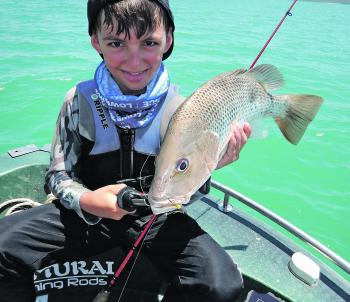
I'm not sure how he does it but every time young Tannhym pulls out the giggle stick he pulls oversized fish for the gear.
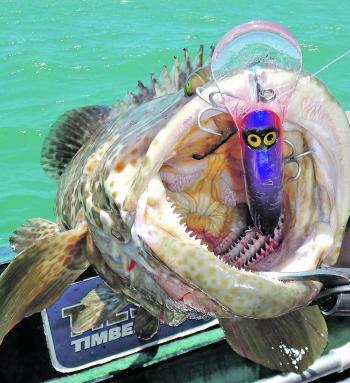
You obviously get a bit of by catch when you’re scanning for fingermark. This decent gold spot cod was released soon after capture minus the old hook lodged in his top lip from a previous encounter.

This customised 4" Prong is an early morning special that is a consistent producer when the waters clear.
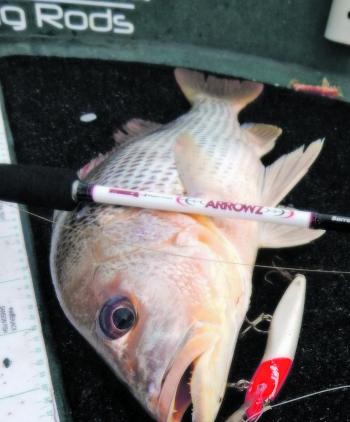
Trolling 125 8m Scorpions is a great way to scan an area in search of fingermark schools. This old battle scarred red head is an old favourite for the job in the early morning.
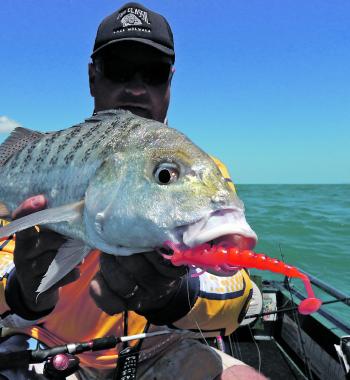
There are some nice big grunter in the deeper areas at present, and the water colour is what will dictate suitable lure selection for the day. This Halco Paddle Prawn is a stable producer in times of murky waters.
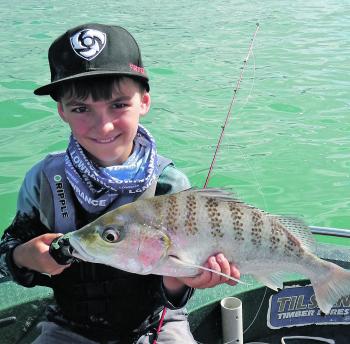
It’s always worth casting a slice at the channel markers on the way past. The young fella cast his favourite Halco Twistie at a beacon for this one.




